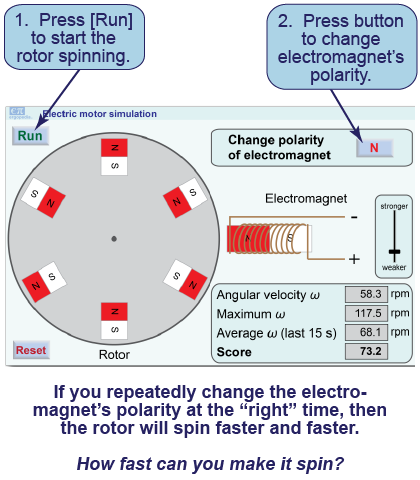|
| Essential questions | | What is the connection between electricity and magnetism in a motor? | |
|
The electric motor is found in many appliances and technologies, including the turntable of a microwave or CD/DVD player, the spinning blades of an electric shaver, and the electric motor in a hybrid electric vehicle. The physics behind the electric motor is the connection between electricity and magnetism. But how does this connection work? In this investigation, you will explore how to use changing electric current in an electromagnet to spin the rotor of a simulated electric motor. How fast can you spin the rotor in this motor? 
|
Part 1: Reversing the electromagnet’s polarity to spin the rotor
 Open the interactive simulation of an electric motor.
Open the interactive simulation of an electric motor. - Press [Run] to start the rotor spinning.
- Press the [N]/[S] button to switch the polarity of the electromagnet at an appropriate time so that the rotor will spin faster.
- See how fast you can get the rotor to spin!
- Change the strength of the electromagnet using the slider and see how fast you can get the rotor to spin.
- What happens when you switch the electromagnet’s polarity when the electromagnet is halfway between two magnets on the rotor?
Does the rotor spin faster or slower? - What happens when you switch the electromagnet’s polarity when the electromagnet is closest to a magnet on the rotor?
Does the rotor spin faster or slower? - When is the ideal time to switch the polarity of the electromagnet? Draw a sketch.
- Write down the angular velocity, maximum angular velocity, average angular velocity, and score for your best run in rotating the motor. Why are the three values of angular velocity different?
- Can you spin the rotor faster when the electromagnet is strong or weak?
Why do you think this is the case? 
|
|
In this interactive simulation of an electric motor, you will press a button to switch the polarity of the electromagnet. If you switch it at the right time, you speed up the rotor. How fast can you spin it?
|
Part 2: Changing magnetic fields and electric current
- Create a coil of wire with at least 10 loops.
- Connect the two wire ends to the lowest current setting of a digital multimeter.
- Quickly insert a stack of magnets into the center of the coil while watching the current reading.
- Hold the magnets in place and watch the current reading.
- Quickly remove the magnets from the coil and watch the current reading.
- What happens to the current through the wire as the magnets move into the coil?
- What happens to the current through the wire as the magnets are held fixed inside the coil?
- What happens to the current through the wire as the magnets are removed from the coil?
- Describe in words the relationship you observe between magnetic fields and electric current.
|

